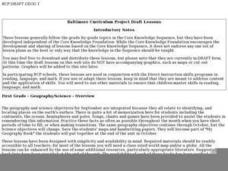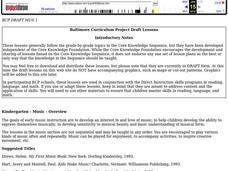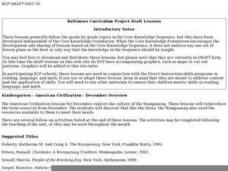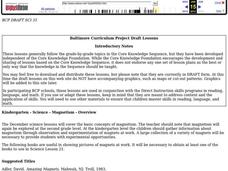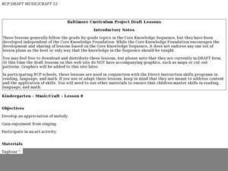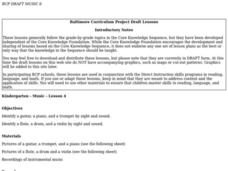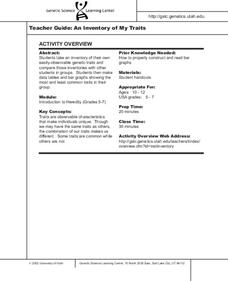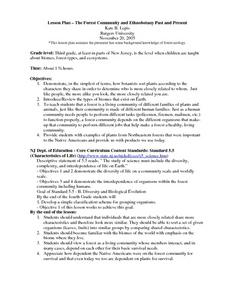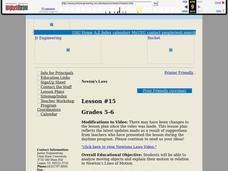Curated OER
Geography: Continents
First graders identify basic geographical facts about the world they live in and distinguish between land and water on a globe. They research the continents and information associated with each one focusing on building their map skills.
Curated OER
Music
Students develop listening skills through repetitive singing. They develop an appreciation of melody.
Curated OER
Visual Arts
Students recognize warm and cool colors in a different medium. They look carefully at slide of medieval stained glass.
Curated OER
November Science
Students review that all people, plants, and animals live on Earth. They classify objects found in the environment as living or nonliving.
Curated OER
Wampanoag Indians
Students read stories and listen to a brief lecture about the Wampanoag Indians, aspects of their culture and their role in the first Thanksgiving. They make a Wampanoag carrying pouch out of a paper bag and cook a corn cake as a class.
Curated OER
Animals and Their Needs
Students identify the characteristics of living things and examine objects to see if they are living. They identify the needs of living things, in particular of animals and animal babies. They discuss how to care for pets.
Curated OER
MAGNETISM
Pupils infer that there are forces we cannot see that act upon objects, experiment with magnets to show a push and/or pull force, and participate in a magnet game.
Curated OER
Music/Craft
Students develop an appreciation of melody. They gain enjoyment from singing. They participate in an art activity.
Curated OER
Literature Overview of African Folktales
Students play a game of tug-of-war, participate in a discussion about the story, discuss the phrase "bigger doesn't mean better." , and illustrate a scene from the story.
Curated OER
Earth/Globe (poles & equator)
First graders create his/her own paper mache earth and label the poles and equator. The land masses can be added and labeling of specific bodies of water. The paper mache earth can then be used to discuss the sun, moon, and the earth and...
Curated OER
Musical Instruments
Students identify a guitar, piano, trumpet, flute, drum, and a violin by sight and sound. They view pictures of each instrument as they are played on a recording, discuss how each instrument makes their particular sound, and listen to...
Curated OER
Geography Overview
Second graders look at the United States often over the next few months. Help them to see how the United States has changed as territories have become states. They may be surprised to know the areas of our country that were territories...
Curated OER
Ancient Roman Monuments and Timeline
While a terrific idea, this lesson in which learners create a timeline showing the date that a variety of buildings and monuments were built in Ancient Rome, requires resources teachers may not have. It requires the use of a Smartboard,...
Curated OER
Sense-Ability
Students use comparisons, graphing, patterning, and sorting, and develop language skills as they explore the five senses.
Curated OER
An Introduction to Sequences
Fourth graders are introduced to arithmetic and geometric sequences. In this mathematics instructional activity, 4th graders produce a variety of sequences by varying the starting number, multiplier, and the add-on number.
Curated OER
Pulleys
Middle schoolers determine how to tell the difference between a simple system and a complex pulley system. Using pulleys, students build simple pulley systems to demonstrate the mechanical advantages of pulleys.
Curated OER
"Very tragical mirth:" Romeo and Pyramus, Juliet and Thisbe
Students analyze and compare the poetic tools Shakespeare uses in the death scenes of Romeo and Juliet to those of Pyramus and Thisbe in Midsummer Night's Dream.
Curated OER
Climate Change
Students discuss problems associated with a world climate change. They examine how animals would be affected if the world heated up.
Curated OER
An Inventory of My Traits
Students take an inventory of their own easily-observable genetic traits and
compare those inventories with other students in groups. They then make
data tables and bar graphs showing the most and least common traits in their group.
Curated OER
Hands-On Investigation!
Students read, analyze, and solve a mystery using problem-solving skills. They explore the History Detective website, discuss the difference between clues and red herrings, complete a dot-to-dot sheet, take notes in a detective...
Curated OER
A Clone of Your Own: The Legal Issues and the Future of Genetic Engineering on Humans
Twelfth graders define cloning in their own words and examine the different types of cloning. After reading an article, they summarize it in their own words and use the internet to research the history of cloning. In groups, they...
Curated OER
The Forest Community And Ethnobotany Past And Present
Students describe a forest as a living community. They determine members interact, and in many cases, depend on each other for their basic survival needs. They investigate how dependent the Native Americans were on the forest...
Curated OER
Newton's Laws
Students experiment with and analyze moving objects and explain their motion in relation to Newton's Laws of Motion. Students then work with partners to design and construct cars that are powered by balloons.
Curated OER
Figure Analysis
Students identify the importance of the Principles and Elements of design through self-analysis and sketching clothing appropriate for their body type. They write the actual color name on a line of the included sheet, then describe why...
Other popular searches
- Core Knowledge Foundation
- Core Knowledge Reading Program
- Core Knowledge Lesson Plans
- Core Knowledge Lessonplans
- Core Knowledge Third Grade
- Core Knowledge Language Arts
- Core Knowledge Math
- Core Knowledge Human Body
- Core Knowledge Secret Garden
- Core Knowledge British
- Core Knowledge Buddha
- Core Knowledge Budha
